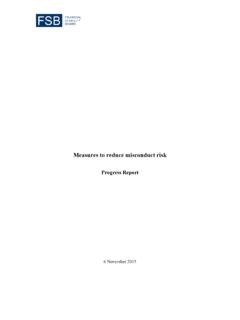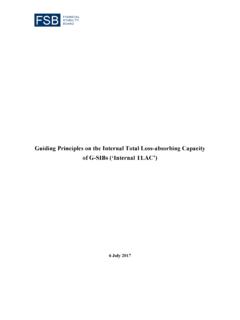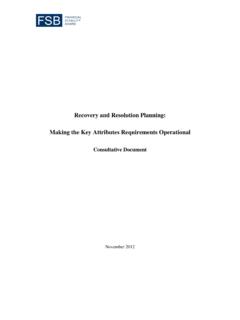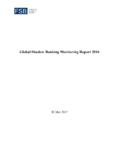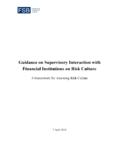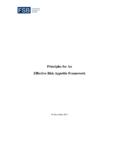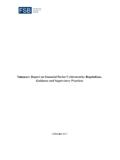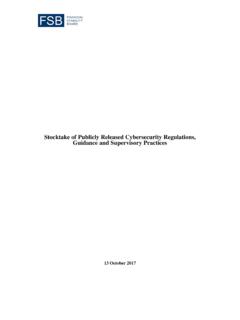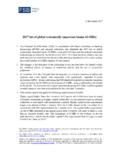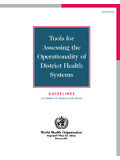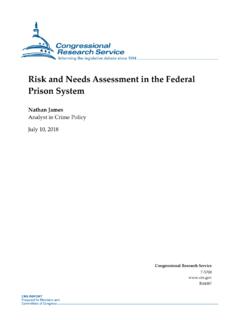Transcription of Framework for Post-Implementation Evaluation of the ...
1 Framework for Post-Implementation Evaluation of the Effects of the G20 Financial Regulatory Reforms 3 July 2017 ii The Financial Stability Board (FSB) is established to coordinate at the international level the work of national financial authorities and international standard-setting bodies in order to develop and promote the implementation of effective regulatory, supervisory and other financial sector policies. Its mandate is set out in the FSB Charter, which governs the policymaking and related activities of the FSB. These activities, including any decisions reached in their context, shall not be binding or give rise to any legal rights or obligations under the FSB s Articles of Association.
2 Contacting the Financial Stability Board Sign up for e-mail alerts: Follow the FSB on Twitter: @FinStbBoard E-mail the FSB at: Copyright 2017 Financial Stability Board. Please refer to: iii Table of Contents Page 1. Introduction .. 1 2. Objectives and scope of the Framework .. 1 Objectives of the Framework .. 1 Scope of the Framework .. 2 3. Concepts and terms .. 3 4. Stylised policy Evaluation concept .. 6 Figure 1: Stylised Policy Evaluation Concept .. 7 5. Evaluation 8 Counterfactuals .. 10 Evaluation tools .. 10 Table 1: Categories of Tools and Types of Evaluations .. 11 Choosing a set of tools .. 11 6. Operationalising reform evaluations.
3 12 Process .. 12 Responsibility for evaluations .. 12 Preparation for evaluations .. 13 Reporting, consultation and follow-up .. 15 Annex A: Existing policy Evaluation frameworks .. 17 Annex B: Examples of policy objectives for priority reform areas .. 20 iv 1 Framework for Post-Implementation Evaluation of the Effects of the G20 Financial Regulatory Reforms 1. Introduction The G20 launched a comprehensive programme of financial reforms post -crisis to increase the resilience of the global financial system, while preserving its open and integrated By making the financial system more resilient and thereby reducing the likelihood and severity of crises, the reforms support the G20 objective of strong, sustainable and balanced growth.
4 The role of the Financial Stability Board (FSB) has been to coordinate the development and support the full, timely and consistent implementation of these reforms. With the main elements of the post -crisis reforms agreed and implementation of core reforms underway, initial analysis of the effects of those reforms is becoming possible. implementation monitoring and the Evaluation of the effects of reforms represent good regulatory practice, form part of the FSB s accountability to the G20 and the public, and inform structured policy discussions among FSB members and standard-setting bodies (SSBs). As stated in its second annual report to the G20 on the implementation and Effects of the G20 Financial Regulatory Reforms, the FSB is working to enhance the analysis of the effects of those reforms, including whether they are working together as intended.
5 To that end, the FSB, in close collaboration with the SSBs, and informed by work carried out by its members and other stakeholders, has developed this Framework for the Post-Implementation Evaluation of the effects of the G20 financial regulatory reforms ( the Framework ) during the German G20 Presidency. Building on the experience with the FSB s 2011 Coordination Framework for implementation Monitoring (CFIM), the Framework specifies processes and analytical approaches for the Evaluation of reforms. Application of the Framework will begin over the coming years, with incremental improvements to the Framework being added as appropriate.
6 2. Objectives and scope of the Framework Objectives of the Framework The Framework will serve as a guide for Post-Implementation Evaluation work by the FSB and SSBs. In particular, it aims to guide analyses of whether the G20 financial regulatory reforms are achieving their intended outcomes, and help identify any material unintended consequences that may have to be addressed, without compromising on the objectives of the reforms. Applying such a Framework will inform structured policy discussions among FSB members and SSBs. Evaluations, if findings warrant it, could provide a basis for possible fine-tuning of post - 1 For more information on the G20 financial regulatory reform agenda, see, for example, the FSB s progress reports to the G20 and the second annual report on the implementation and Effects of the G20 Financial Regulatory Reforms.
7 2 crisis regulatory reforms, without implying a scaling back of those reforms or undermining members commitment to implement them. The regulatory reform process follows a policy cycle that comprises: (i) identifying a market failure, risk or problem that requires attention; (ii) designing, consulting on, and adopting the appropriate policy response; (iii) implementing the policy and monitoring that implementation ; and (iv) evaluating the effects, and where warranted, revisiting steps (i) and (ii) to determine whether any additional actions are required in light of sufficient evidence. The length of the policy cycle would differ across reform areas, not least because different regulatory measures can take more or less time to play out through the financial system and the real economy.
8 A structured Evaluation Framework adds to the policy cycle by setting out general guidelines for Post-Implementation evaluations, by clarifying roles and responsibilities, and by helping to select and prioritise Evaluation topics. As such, the Framework should help to manage the methodological challenges inherent in any policy Evaluation study. These challenges include analysing a multitude of transmission channels and behavioural responses, accounting for complex interactions among regulatory and non-regulatory factors, deriving measurable benchmarks for assessment of policies, estimating benefits and costs (including long-term effects and social costs) and considering data gaps (see Box 1).
9 These challenges are not unique to financial reforms, and are relevant for policy development and Evaluation in other areas ( competition, tax, environmental, health, and labour-market policies). Addressing these challenges through robust evaluations will evolve with experience. Thus, the Framework is a living document that will be enhanced as experience is gained and its roll-out will take place progressively in the coming years. Scope of the Framework The focus of the Framework is on Post-Implementation Evaluation ; that is, evaluating the effects of G20 financial regulatory reforms for which implementation is well underway or completed. The Framework will cover ex ante analysis only to the extent that it is necessary for Post-Implementation Evaluation , such as translating policy objectives, set out at the time of development, into observable and measurable outcomes, and comparing available ex ante impact assessments with realised outcomes.
10 The Framework is being designed with the post -crisis G20 core reform areas in mind, but it should provide flexibility to allow tailoring evaluations to other including future reforms, and the potential for individual jurisdictions to use it, if they desire. In particular, the core reform areas to which the Framework will be applied are: (1) making financial institutions more resilient; (2) ending too-big-to-fail; (3) making derivatives markets safer; and (4) transforming shadow banking into resilient market-based finance. The Framework can be applied both to individual reforms, as well as to cross-sectoral and cross-cutting issues stemming from the interaction and combined effects of those reforms, on key aspects relating to the functioning of the global financial system.
